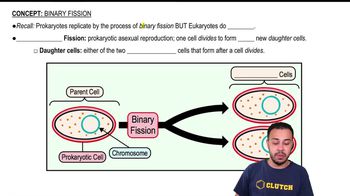Which of the following pairs is mismatched?
a. metachromatic granules—stored phosphates
b. polysaccharide granules—stored starch
c. lipid inclusions—poly-β-hydroxybutyric acid
d. sulfur granules—energy reserve
e. ribosomes—protein storage
 Tortora 14th Edition
Tortora 14th Edition Ch. 4 - Functional Anatomy of Prokaryotic and Eukaryotic Cells
Ch. 4 - Functional Anatomy of Prokaryotic and Eukaryotic Cells Problem 6.1a
Problem 6.1a Verified step by step guidance
Verified step by step guidance



Which of the following pairs is mismatched?
a. metachromatic granules—stored phosphates
b. polysaccharide granules—stored starch
c. lipid inclusions—poly-β-hydroxybutyric acid
d. sulfur granules—energy reserve
e. ribosomes—protein storage
You have isolated a motile, gram-positive cell with no visible nucleus. You can assume this cell has
a. ribosomes.
b. mitochondria.
c. an endoplasmic reticulum.
d. a Golgi complex.
e. all of the above
Match the characteristics of eukaryotic cells in column A with their functions in column B.
<IMAGE>
Use the following graph to answer questions 3 and 4.
<IMAGE>
Which of the lines best depicts the log phase of a thermophile incubated at room temperature?
Use the following graph to answer questions 3 and 4.
<IMAGE>
Which of the lines best depicts the log phase of Listeria monocytogenes growing in a human?
Assume you inoculated 100 facultatively anaerobic cells onto nutrient agar and incubated the plate aerobically. You then inoculated 100 cells of the same species onto nutrient agar and incubated the second plate anaerobically. After incubation for 24 hours, you should have
a. more colonies on the aerobic plate.
b. more colonies on the anaerobic plate.
c. the same number of colonies on both plates.